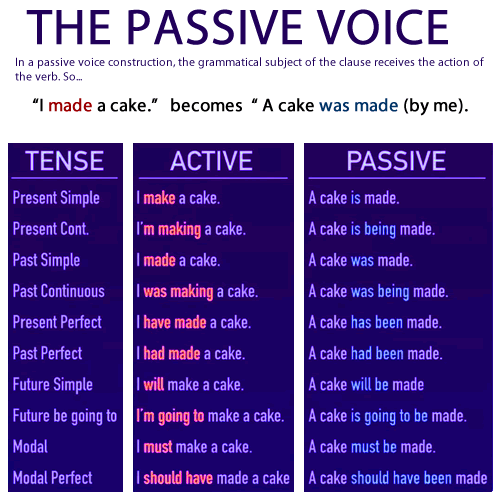
There are two voices in English (and most other languages), ACTIVE and PASSIVE.
ACTIVE: Isabella ate the burrito.
In this sentence, the subject, Isabella, performed the action, and the object, the burrito, suffered the action.
To express something in the PASSIVE voice, the idea needs to have an OBJECT.
Why? Because in the passive voice, the OBJECT (of the active sentence) occupies the SUBJECT place.
We make the passive by putting the verb ‘to be’ into the tense we need (refer to the active sentence) and then adding the past participle of the action. In our example, The object of the active sentence, the burrito, becomes the SUBJECT of the passive sentence. The active sentence is in the simple past so the verb ‘to be’ must be also in the past and conjugated for our “new” subject, the burrito (third person singular). We then add the past participle of the action (eat/ate/eaten) and then we can complete the idea by adding the prepositional phrase ‘by Isabella.’
PASSIVE: The burrito was eaten (by Isabella).
This is one of the few areas that has logic and NO EXCEPTIONS!
Look at a few more examples in other tenses:
- PRESENT: I teach English – English is taught (by me).
- PRESENT CONTINUOUS: She is watching TV – TV is being watched (by her)
- PRESENT PERFECT: I have visited three museums today – Three museums have been visited by me today.
- MODAL: Tom can play the piano – The piano can be played (by Tom)
If you have any questions or doubts, please ask in the comments or send me a private message.
Follow me on Instagram: @englishyourwaybr
or look for the hashtag #LearnEnglishWithCarlo

3 comments
How can I say in the passive
The policeman didn’t allow US to enter the museum at night
Author
Great Question Marie,
In the passive voice, you would say “We weren’t allowed to enter the museum at night (by the policeman).”
Great explanation of the passive voice, Carlo! I appreciate the examples you provided; they really helped clarify the concept. Looking forward to more grammar tips!